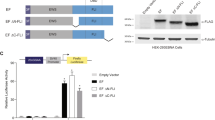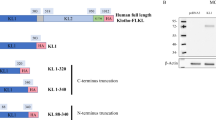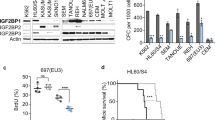Abstract
WE have developed an efficient expression cloning system that allows rapid isolation of complementary DNAs able to induce the transformed phenotype1, 2. We searched for molecules expressed in epithelial cells and possessing transforming potential to fibro-blasts, and cloned a cDNA for the normal receptor of a growth factor secreted by NIH/3T3 cells3, 4. Here we report a second novel transforming gene, ect2. The isolated cDNA is activated by amino-terminal truncation of the normal product. The Ect2 protein has sequence similarity within a central core of 255 amino acids with the products of the breakpoint cluster gene, bcr (ref. 5), the yeast cell cycle gene, CDC24 (ref. 6), and the dbl oncogene7. Each of these genes encodes regulatory molecules or effectors for Rho-like small GTP-binding proteins8–10. The baculovirus-expressed Ect2 protein could bind highly specifically to Rho and Rac proteins, whereas the dbl product showed broader binding specificity to Rho family proteins. Thus ect2 is a new member of an expanding family, whose products have transforming properties and interact with Rho-like proteins of the Ras superfamily.
This is a preview of subscription content, access via your institution
Access options
Subscribe to this journal
Receive 51 print issues and online access
$199.00 per year
only $3.90 per issue
Buy this article
- Purchase on Springer Link
- Instant access to full article PDF
Prices may be subject to local taxes which are calculated during checkout
Similar content being viewed by others
References
Miki, T., Matsui, T., Heidaran, M. A. & Aaronson, S. A. Gene 83, 137–146 (1989).
Miki, T. et al. Proc. natn. Acad. Sci. U.S.A. 88, 5167–5171 (1991).
Miki, T. et al. Science 251, 72–75 (1991).
Miki, T. et al. Proc. natn. Acad. Sci. U.S.A. 89, 246–250 (1992).
Hariharan, I. K. & Adams, J. M. EMBO J. 6, 115–119 (1987).
Hartwell, L. H., Mortimer, R. K., Culotti, J. & Culotti, M. Genetics 74, 267–286 (1973).
Eva, A. & Aaronson, S. A. Nature 316, 273–275 (1985).
Diekmann, D. et al. Nature 351, 400–402 (1991).
Bender, A. & Pringle, J. R. Proc. natn. Acad. Sci. U.S.A. 86, 9976–9980 (1989).
Hart, M. J., Eva, A., Evans, T., Aaronson, S. A. & Cerione, R. A. Nature 354, 311–314 (1991).
Ron, D. et al. New Biol. 3, 372–379 (1991).
Adams, A. E. M., Johnson, D. I., Longnecker, R. M., Sloat, B. F. & Pringle, J. R. J. Cell Biol. 111, 131–142 (1990).
Munemitsu, S. et al. Molec. cell Biol. 10, 5977–5982 (1990).
Shinjo, K. et al. Proc. natn Acad. Sci. U.S.A. 87, 9853–9857 (1990).
Summers, M. D. & Smith, G. E. Texas Exp Station Bulletin N. 1555 (1987).
Bischoff, F. R. & Ponstingl, H. Proc. natn. Acad. Sci. U.S.A. 88, 10830–10834 (1991).
Drivas, G. T., Shih, A., Coutavas, E., Rush, M. G. & D'Eustachio, P. Molec. cell. Biol. 10, 1793–1798 (1990).
Miyamoto, S., Ohya, Y., Ohsumi, Y. & Anraku, Y. Gene 54, 125–132 (1987).
Maru, Y. & Witte, O. N. Cell 67, 459–468 (1991).
Pendergast, A. M., Muller, A. J., Havlik, M. H., Maru, Y. & Witte, O. N. Cell 66, 161–171 (1991).
Adams, J. M., Houston, H., Allen, J., Lints, T. & Harvey, R. Oncogene 7, 611–618 (1982).
Shou, C., Farnsworth, C. L., Neel, B. G. & Feig, L. A. Nature 358, 351–354 (1992).
Miyamoto, S. et al. Biochem. biophys. Res. Commun. 181, 604–610 (1991).
Prickett, K. S., Amberg, D. C. & Hopp, T. P. Biotechniques 7, 580–589 (1989).
Studier, W., Rosenberg, A. H., Dunn, J. J. & Dubendorff, J. W. Meth. Enzym. 185, 60–89 (1990).
Vincent, S., Jeanteur, P. & Fort, P. Molec. cell. Biol 12, 3138–3148 {1992).
Yeramin, P., Chardin, P., Madaule, P. & Tavitian, A. Nucleic Acids Res. 15, 1869–1869 (1987).
Smith, D. B. & Johnson, K. S. Gene 67, 31–40 (1988).
Author information
Authors and Affiliations
Rights and permissions
About this article
Cite this article
Miki, T., Smith, C., Long, J. et al. Oncogene ect2 is related to regulators of small GTP-binding proteins. Nature 362, 462–465 (1993). https://doi.org/10.1038/362462a0
Received:
Accepted:
Issue Date:
DOI: https://doi.org/10.1038/362462a0
This article is cited by
-
ECT2 promotes malignant phenotypes through the activation of the AKT/mTOR pathway and cisplatin resistance in cervical cancer
Cancer Gene Therapy (2023)
-
Two RhoGEF isoforms with distinct localisation control furrow position during asymmetric cell division
Nature Communications (2023)
-
Increased expression of ECT2 predicts the poor prognosis of breast cancer patients
Experimental Hematology & Oncology (2022)
-
Mapping the proximity interaction network of the Rho-family GTPases reveals signalling pathways and regulatory mechanisms
Nature Cell Biology (2020)
-
StarD13: a potential star target for tumor therapeutics
Human Cell (2020)
Comments
By submitting a comment you agree to abide by our Terms and Community Guidelines. If you find something abusive or that does not comply with our terms or guidelines please flag it as inappropriate.



